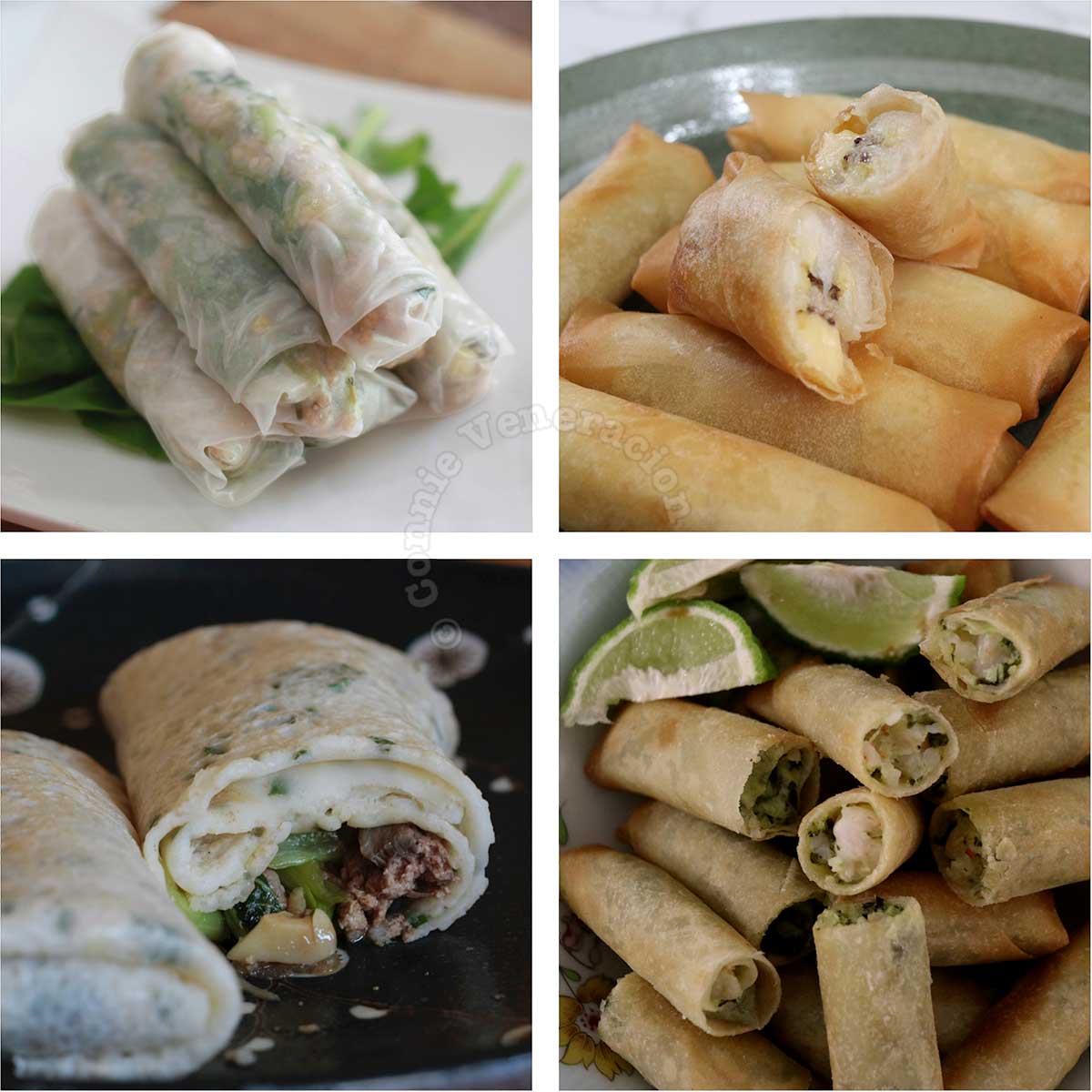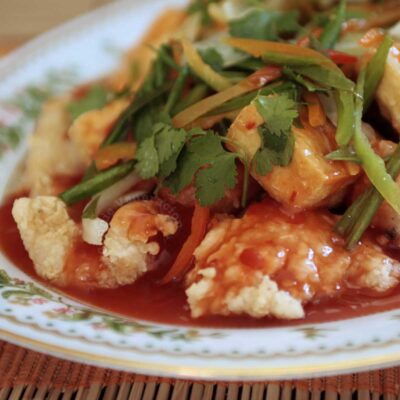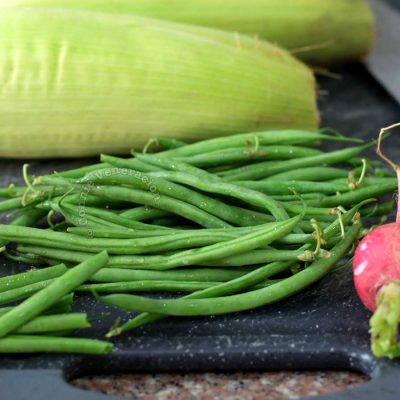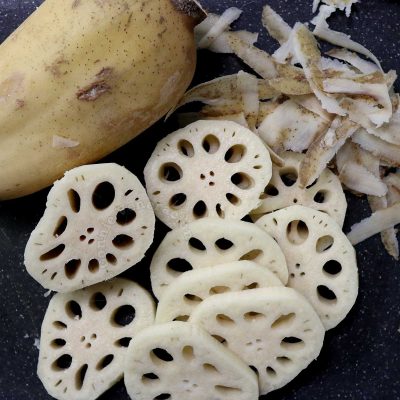Spring rolls called cha gio are served as an appetizer in Vietnam using paper-thin rice wrappers sun dried on baskets. The Fujian style fresh non-fried spring roll with the flour-based wrapper is known in Taiwan, Singapore and Malaysia as popiah (or poh piah). In the Philippines, savory spring rolls are lumpia. If the filling is sweet, it’s turon.
It’s a lot to cover and a lot to understand especially if you’re not Asian and you tend to think that spring rolls are necessarily fresh and, when fried, they are called egg rolls.
I understand that in America, frying spring rolls entails dipping them in egg and coating them in flour before they go into the hot oil. And, hence, they are called “egg rolls”. The egg and flour coating is American, not Asian. With a few exceptions, both egg and flour are unnecessary to give fried spring rolls their signature crispness.
So, just to reiterate, spring rolls are either fresh or fried. There are savory spring rolls and there are sweet spring rolls. When served, the wrapper can be soft, chewy or crispy. Some spring rolls require dipping sauces or accompaniments.
Spring roll wrappers
You might have wondered why spring roll wrappers vary in color, texture and mouth feel. That’s because the ingredients for making the wrapper, and how the wrappers are made, vary.
Flour-based spring roll wrappers
The most common spring roll wrapper is made with flour, water and salt. You can buy them in the market or in the frozen section of the grocery. It is essentially a dough and how that dough is transformed into uniformly-sized paper-thin wrappers is an interesting technique.
Because this type of spring roll wrapper is so widely available, we don’t need to make them at home. We buy packs of wrapper and freeze them until needed. How long do they stay good in the freezer? A few weeks. The expiry date may suggest that they will last longer but, once opened, the wrappers dry out fast, harden and lose their pliability.
Rice paper
If you’ve had Vietnamese spring rolls, you might have wondered why the wrapper has a checkered texture. That’s because of the way they are prepared. Made with rice flour and water (sometimes, tapioca starch is added or it totally replaces rice flour), rice paper is steamed then dried on special racks made with woven dried grass.

While rice paper is commonly associated with Vietnamese spring rolls, they are used in other ways. During a street food tour in Ho Chi Minh City, we were introduced to “Vietnamese pizza” which is prepared with rice paper.
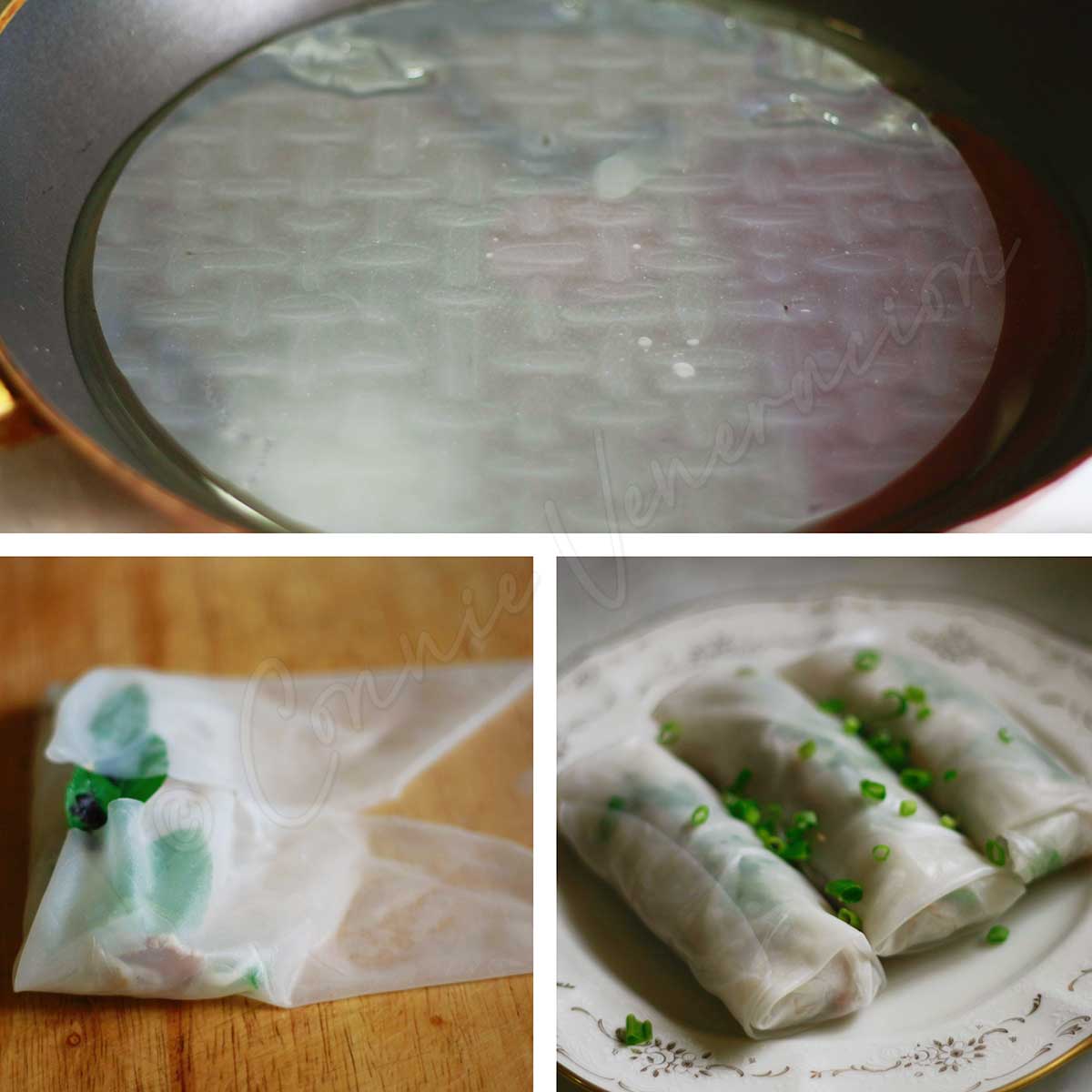
For home cooking, rice paper needs to be moistened to soften them and to make them pliable enough to be filled and rolled. Simply dip the rice paper in water for a few seconds, lift and shake off excess water, lay flat and use as you would the flour-based spring roll wrapper.
Crepe-like spring roll wrappers
In the Philippines, this is the wrapper used for lumpiang ubod (spring rolls with heart of palm filling). You won’t find this wrapper in the grocery so we make it at home.
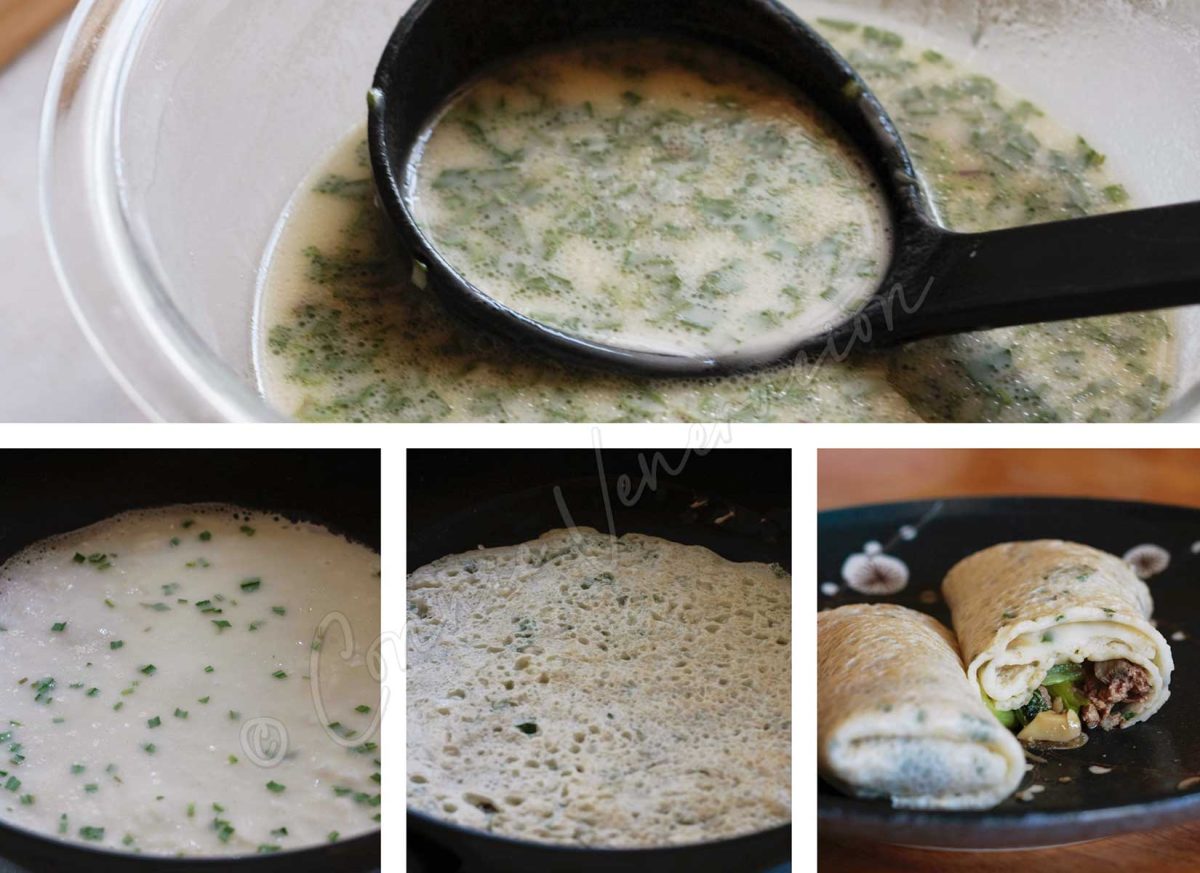
The thin batter is a mixture of flour, corn starch, eggs and water. I like to add chopped herbs occasionally. The wrapper is cooked in the same way you’d made French crepes. Ladle into a non-stick pan, cook, flip, cook and it’s ready to be used.
How to wrap spring rolls for frying
Whether you’re using regular wrappers or rice paper (no, you can’t fry crepe-like wrappers), making a spring roll for frying follows the same basic technique. The photos below is for cheese and banana spring rolls but the technique is the same whether the filling is sweet or savory.
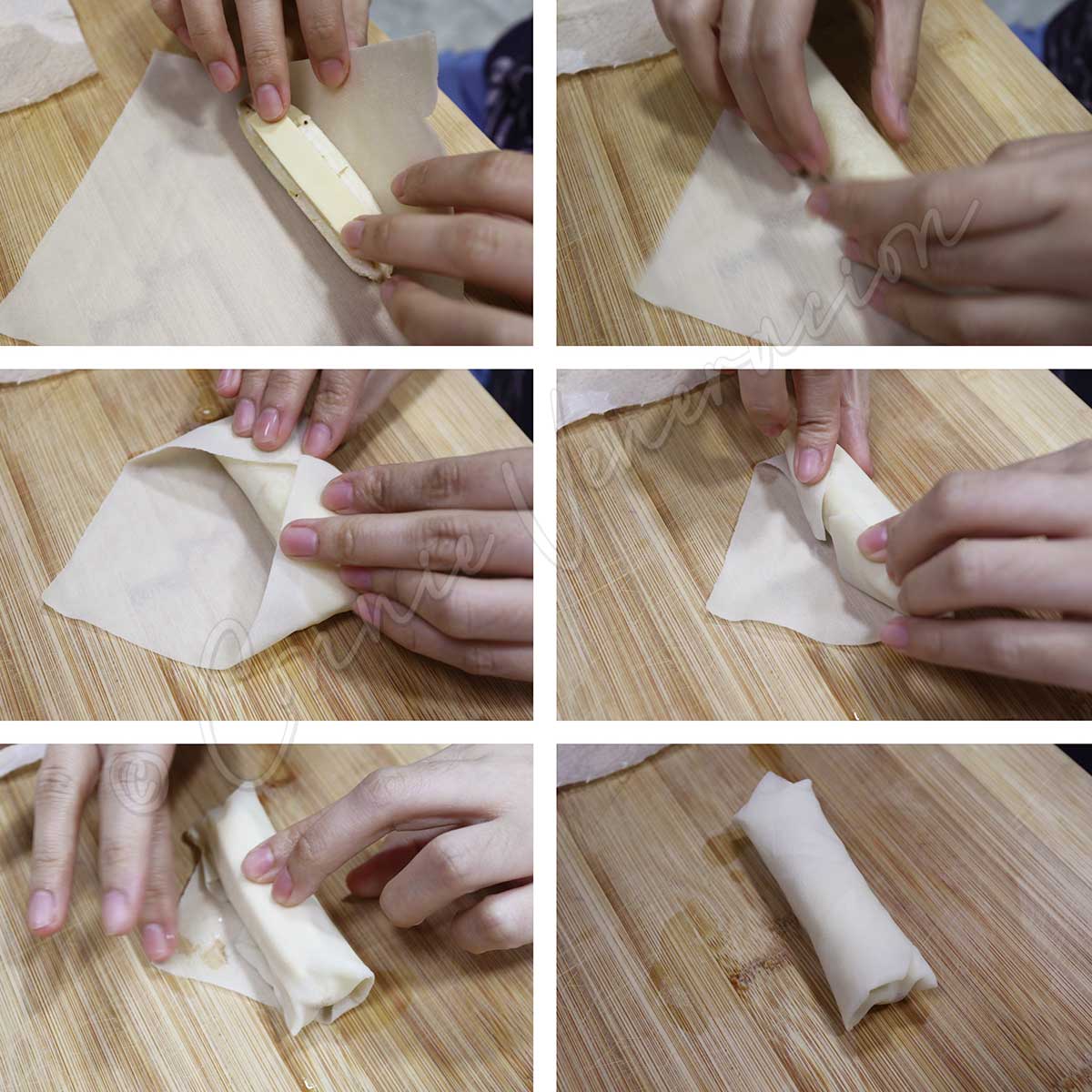
You need to seal in the filling so that the juices and flavors don’t drip into the cooking oil. If the filling consists of raw ingredients (especially raw meat), you can’t put in too much filling because the cooking time is short — just long enough to brown the wrapper — and a thick filling will not get cooked through.
- Place the filling across the center of the wrapper.
- Fold the corner (or edge if you’re using a round wrapper) of the wrapper nearest you over the filling.
- Take one corner (or edge) on the side and fold it inward. The fold should be where the filling ends. Do the same with the opposite side.
- Brush the edges farthest from you with the egg wash or water.
- Start rolling the spring roll away from you, rolling as tightly as you can. Keep on rolling until you reach the edges brushed with egg wash or water.
When you have used up all your wrappers or filling, whichever comes first, your spring rolls are ready to go into the frying pan. Or store the spring rolls for frying at a later time.
How to store uncooked spring rolls
First, let me just say that NOT all uncooked spring rolls can be stored for later use. Those with mostly vegetable filling cannot be frozen. What we store in the freezer are uncooked spring rolls with meat filling, those with sweet filling like banana and spring rolls where the main filling is cheese.
The thing about spring rolls is that the wrapper can get soaked with the juices of the filling. That’s why, ideally, spring rolls should go directly into the hot oil after they are wrapped. So, how do we prevent the wrappers from getting soaked?
Use flour or starch to separate the spring rolls
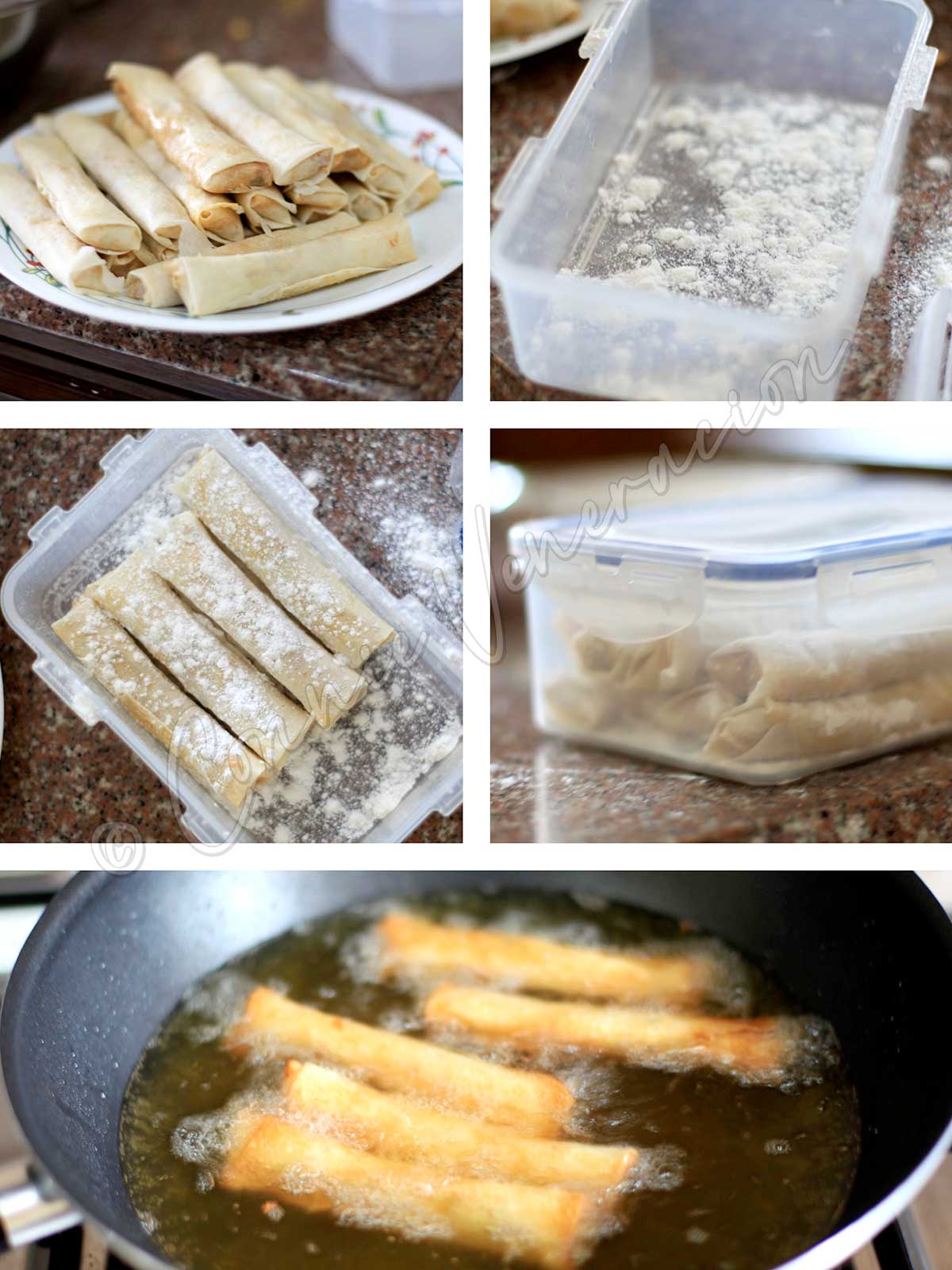
Take a freezer container and sprinkle the bottom generously with flour or starch (corn starch, potato starch or tapioca starch will all work).
Lay the spring rolls on the floured bottom of the container — single file and not too tightly. Sprinkle the spring rolls with more starch or flour. Repeat until all the spring rolls are in the container.
The flour or starch will soak up any excess liquid and moisture that gets absorbed by the spring roll wrappers. It will also prevent the spring rolls from sticking to each other. As an added bonus, the flour or starch will form a kind of coating that will turn crisp when the spring rolls are fried.
Do the spring rolls need to be thawed before frying?
NO. Since you can easily separate them from one another even in their frozen state, you can fry them directly. But since they are frozen, you will need to fry them in smaller batches to make sure that the oil in the frying pan stays hot enough to make them crisp. If you overcrowd the pan, the temperature of the oil will drop and you will be SIMMERING the spring rolls in lukewarm oil rather than frying them.
And just where did I learn all that? If you spend time browsing through grocery shelves and freezers, make an effort to read the labels of products even if you’re not buying them. Frozen food items are everywhere in groceries — ready-to-fry spring rolls, French fries, hash browns… What do the cooking instructions say?
DO NOT THAW. Because anything frozen is stiff. When the ice starts melting, the stiffness goes. You want the spring rolls or French fries or hash browns to start browning in hot oil at once — it’s like making the food go from one stiff stage (frozen) to another stiff stage (fried) without allowing it to go through the soggy stage in between.
It’s not rocket science and I sure as hell can’t explain it in more impressive and precise scientific language. But if you’ve been cooking for a long time and you bother observing what actually happens during the cooking process, well, you notice a thing or two. I know I do.
How to reheat fried spring rolls
This only applies to fried spring rolls with meat or seafood filling that contains a meagre amount of chopped vegetables. There really is no effective way to reheat all-vegetable spring rolls.
The most common mistake when reheating fried spring rolls is to use oil. I tell you, there is enough oil in the spring roll wrappers and you don’t need more.
The second most common mistake is to reheat the spring rolls using high heat. High heat is essential when cooking the spring rolls because the wrappers are uncooked at that point. But after they have been fried, subjecting them to high heat again is a sure way to burn them.
On the stove top
It is best to use a non-stick pan which has been lightly heated. Arrange the cold spring rolls in a single layer and reheat. Low heat only. After about three minutes, turn them over and reheat the other side. When you turn them over, you will already notice that the side that had already been reheated has turned crisp once more.
In an air fryer
Arrange the cold spring rolls in a single layer in the air fryer basket. Use medium heat then set the timer to seven to ten minutes depending on the thickness of the spring rolls and the wattage of the air fryer.
In the oven or oven toaster (but not the microwave)
An oven or oven toaster will require preheating. An oven is ideal if reheating a large amoung to cooked spring rolls that had been kept in the fridge. Reheat smaller amounts in an oven toaster.
Whether using an oven or an oven toaster, preheat before even taking the spring rolls out of the fridge to prevent condensation of moisture on the surface of the spring rolls.
Once the oven or oven toaster is hot, arrange the spring rolls on a rack in a single layer. Reheat at 325F for about ten minutes.

